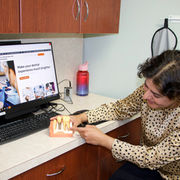How is Oral Cancer Detected?
- Dr. Michael Ofir

- Apr 30, 2021
- 2 min read
Oral cancer is one of the most prevailing conditions in the world. The current statistics show that every year about 54,000 Americans diagnosed with oral cancer and it causes 57% of deaths with 5 years survival rate. There is a long debate about the risk factors and causes of mouth cancer. The most common reported causes are the use of tobacco, persistent viral infections, and alcohol consumption. Oral cancer is most frequent in patients above 55, but it can occur in young people as well.
According to our Dentists in Cambridge and Somerville, MA, that early diagnosis and intervention can improve the survival rate, early cure, and rehabilitation. The advancement in diagnostic procedures makes it possible to diagnose oral cancer at an early or precancerous stage. The current detection methods for mouth cancer are listed in this article.

Clinical Examination
The regular dental checkup can detect any potential mouth cancer in its early stages without any signs and symptoms. In physical examination Oral cancer can represent a red and white patch, irritation, hardness in texture, redness, or ulcer. These changes referred to as precancerous lesions. The timely detection can find the underlying cause and helps in disease intervention.
Biopsy
The most standard testing method to detect oral cancer is a biopsy. A biopsy is a procedure in which a small portion of the suspected area is removed for histological evaluation. Biopsy confirms the presence and the type of oral cancer for further treatment plans. If the lesion is smaller in size the biopsy can fully remove the portion of the disease.
X-ray
The other method to detect oral cancer is radiographic imaging techniques. The X-ray detects the structures associated with the cancerous portion. Sometimes it’s the first diagnostic procedure for mouth cancer. An X-ray can also detect the spread of cancer to the lungs and other organs.
Computed tomography and Magnetic resonance imaging (MRI)
Both are similar diagnostic tools. The CT scan diagnoses the soft tissues while the MRI finds the hard tissue details. They help to detect the involvement of other body structures, like the lymph nodes and other vital structures. The oral squamous cell carcinoma which is the most common mouth cancer can metastasize to the adjacent lymph nodes of the mouth and throat. The imaging techniques will help to detect the cancerous portion on metastasized sites.
Oral Cancer Self-Exam
Self-evaluation is another vital tool in the diagnosis of mouth cancer. If you have any unhealing ulcer without any visible causes for more than 2 weeks, or any unusual red and white patch, or any associated risk factor you should visit one of our dentists in Somerville and Cambridge, MA for oral cancer screening.
For more information call one of our dental offices or contact us online.

















Comments